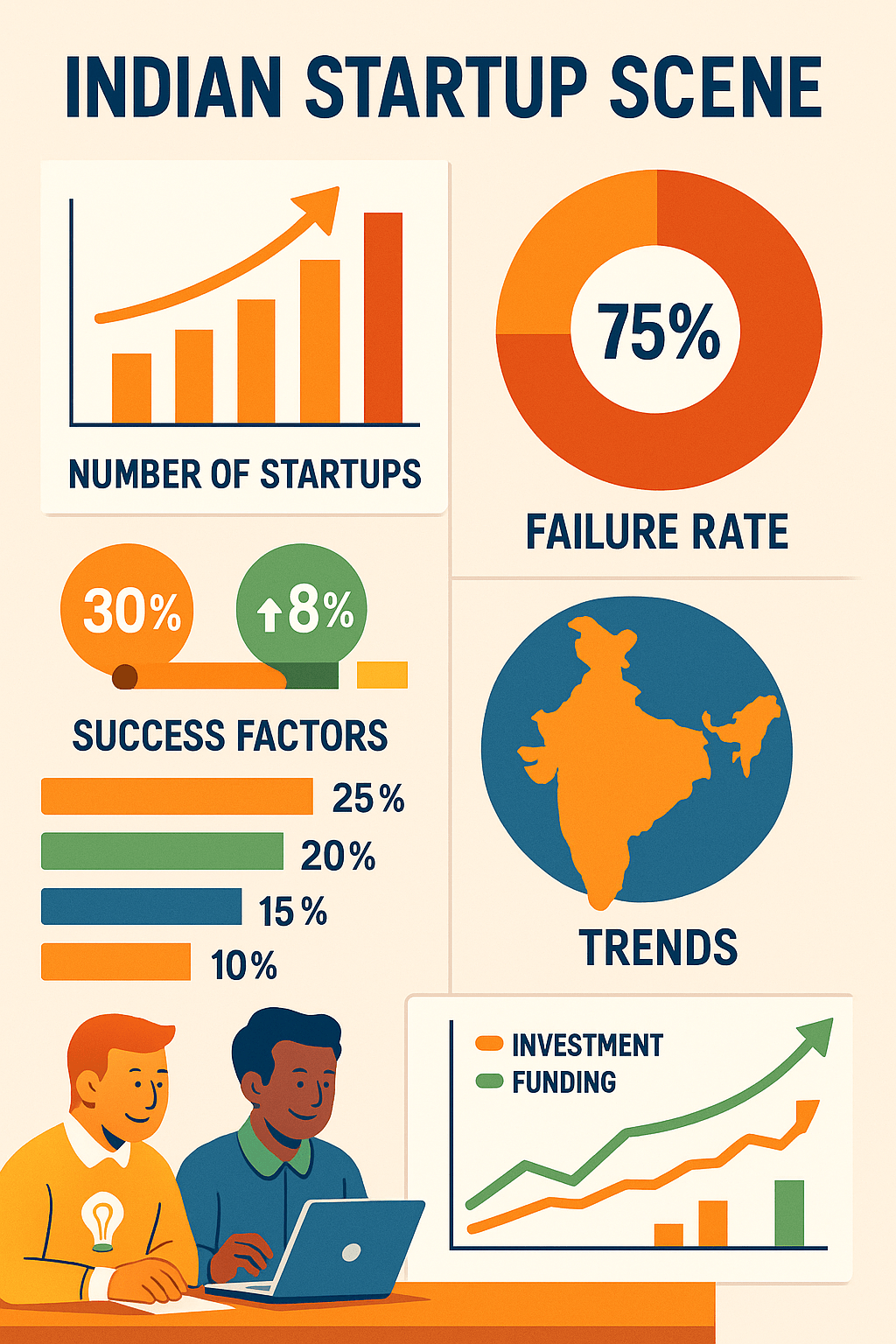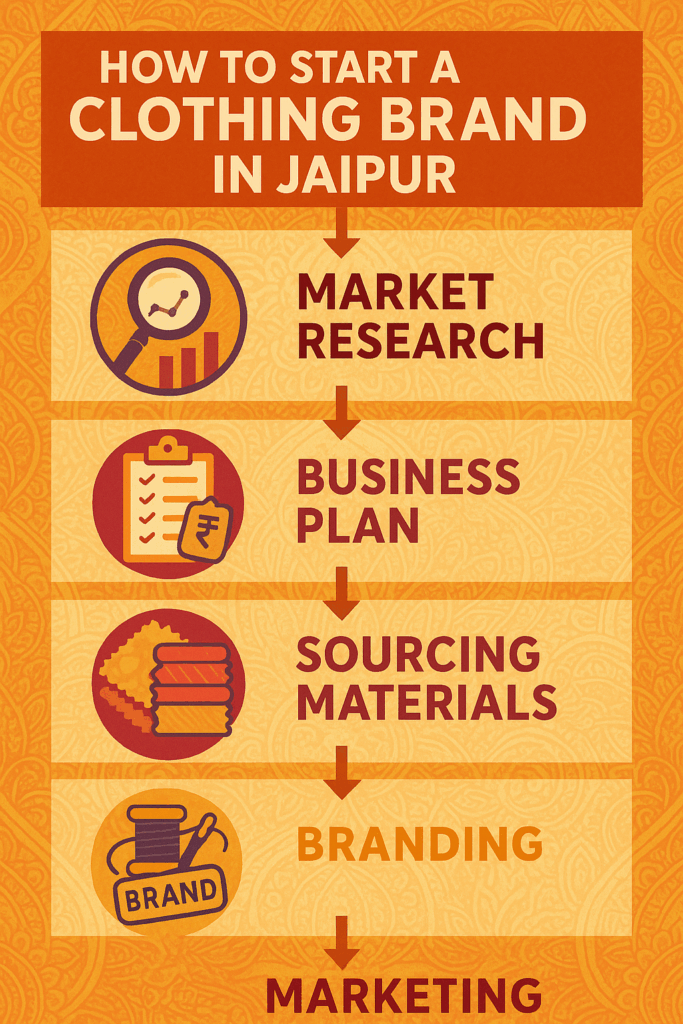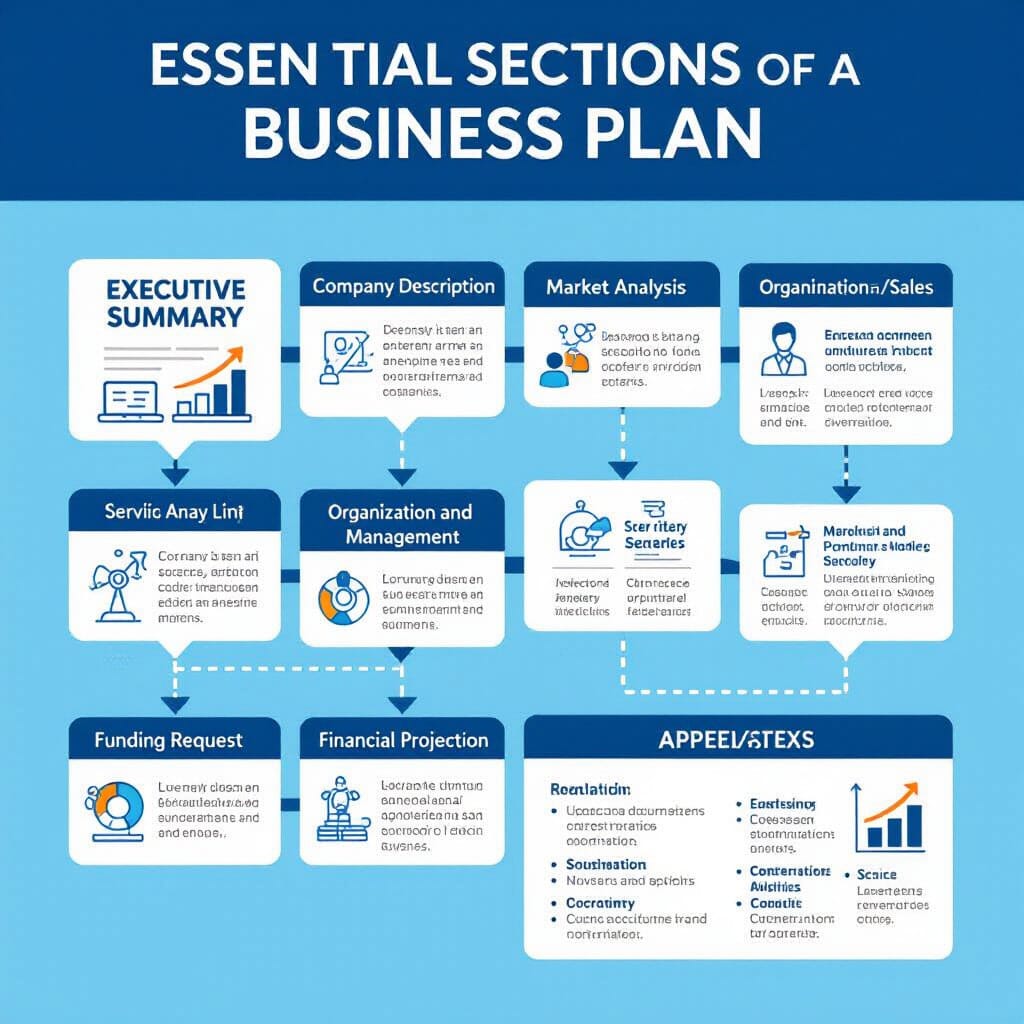Why Startups Fail in India: Lessons from Success and Strategies for Growth

Introduction: The Indian Startup Landscape
India has emerged as one of the world’s fastest-growing startup ecosystems. With a young and tech-savvy population, a growing middle class, and increasing government support through initiatives such as “Startup India,” the country has become a hub for innovation and entrepreneurship. In 2023, India was home to over 90,000 startups, making it the third-largest startup ecosystem globally, behind only the United States and China.
However, despite the rapid growth and the sheer number of new ventures, the failure rate among Indian startups remains alarmingly high. According to a report by Nasscom, approximately 95% of startups in India fail within the first five years. This raises an important question: Why do so many startups in India struggle to survive and thrive?
The answer lies in a combination of factors, including inadequate funding, poor business models, regulatory challenges, and a lack of market understanding. While the Indian startup ecosystem is growing rapidly, it’s still in its early stages, and many entrepreneurs are learning the hard way about the complexities of building a sustainable business.
This article examines the reasons behind startup failures in India, highlights the success stories of those who have overcome these challenges, and provides practical strategies to help new entrepreneurs avoid common pitfalls. Whether you’re an aspiring founder, an investor, or a business student, understanding the dynamics of the Indian startup ecosystem is crucial for success.
Key Statistics: The Reality of Startup Failure in India
Before diving into the reasons behind startup failures, it’s essential to understand the data that paints a clearer picture of the Indian startup landscape. Here are some key statistics from recent reports:
- Failure Rate: Around 95% of startups in India fail within five years, according to Nasscom.
- Funding Challenges: A report by YourStory states that only 1% of Indian startups receive venture capital funding.
- Survival Rate: Only 10-15% of startups survive beyond three years, with less than 5% becoming profitable within that timeframe.
- Exit Value: The average exit value for Indian startups is around $50 million, but only a small fraction achieve this milestone.
- Women-led Startups: According to a report by the Indian Angel Network, women-led startups receive less than 2% of the total funding in the country.
These statistics highlight the challenges faced by startups in India. While the ecosystem is growing, the numbers also suggest that most startups either run out of money or fail to adapt to market demands.
Challenges: Common Reasons Why Startups Fail in India
Startup failure is a complex issue with no single cause. However, several common factors contribute to the high failure rate among Indian startups. Let’s break them down in detail.

1. Lack of Market Fit
One of the most cited reasons for startup failure is the lack of product-market fit. This means that the product or service does not meet the needs of the target audience. Many Indian startups launch with a solution in search of a problem, often without proper market research. According to research from Harvard Business School, understanding why startups fail in India is crucial for entrepreneurs to avoid similar mistakes and build successful businesses.
For example, some startups attempt to replicate successful Western models without considering the cultural and economic differences in India. This can lead to a mismatch between the product and the local market, resulting in poor adoption rates and low revenue.
2. Insufficient Funding
Funding is another major hurdle for Indian startups. While there has been a surge in angel investors and venture capital firms in recent years, the majority of startups still struggle to secure adequate funding. Many entrepreneurs rely on bootstrapping or family support to launch their businesses, which can limit their ability to scale.
Moreover, the funding landscape is highly competitive. Only a small percentage of startups receive Series A or B funding, and even fewer go on to secure Series C or D funding. This makes it difficult for startups to sustain operations and compete with established players.
3. Poor Business Models
A flawed business model can doom a startup before it even gets off the ground. Many Indian startups fail to develop a clear revenue strategy or sustainable growth plan. Some businesses operate on the assumption that they will eventually monetize their product or service. Still, without a viable path to profitability, they often run out of cash.
Another issue is the over-reliance on venture capital. Some startups spend heavily on marketing and customer acquisition without a clear plan for generating revenue. This can lead to a situation where the startup is experiencing rapid growth. Still, it’s not generating a profit, which makes it a risky investment for investors.Research from Nasscom highlights that sustainable business models are crucial for long-term success in the Indian startup ecosystem.
4. Regulatory and Bureaucratic Hurdles
India has made significant progress in streamlining business regulations; however, for many startups, the bureaucratic process remains a major roadblock. From obtaining licenses to complying with tax and labor laws, the regulatory environment can be complex and time-consuming.
For example, startups in the fintech and e-commerce sectors often face strict compliance requirements. While these regulations are designed to protect consumers, they can also create unnecessary barriers for new businesses trying to enter the market.
5. Talent Acquisition and Retention
Attracting and retaining top talent is another challenge for Indian startups. Many startups struggle to compete with larger corporations when it comes to offering competitive salaries and benefits. Additionally, the startup culture in India is still evolving, and not all entrepreneurs possess the skills necessary to manage teams or establish a strong company culture.
This can lead to high employee turnover, which not only affects productivity but also increases hiring and training costs. Moreover, a lack of experienced mentors and advisors can hinder a startup’s growth and decision-making.
6. Intense Competition
India’s market is highly competitive, particularly in sectors such as e-commerce, fintech, and edtech. Many startups enter crowded markets without a unique value proposition, making it difficult for them to stand out. In such cases, even a small misstep can lead to failure. Understanding why startups fail in India helps entrepreneurs differentiate their offerings and develop competitive advantages.
For example, the e-commerce sector in India is dominated by giants like Flipkart and Amazon India. New entrants often struggle to gain market share unless they offer something truly innovative or different.
Case Studies: Success Stories in the Indian Startup Ecosystem
Despite the challenges, several Indian startups have managed to overcome the odds and achieve remarkable success. These case studies offer valuable insights into what works and how entrepreneurs can navigate the startup ecosystem effectively.
1. Flipkart: From a Dorm Room to a Billion-Dollar Business
Flipkart, one of India’s most successful e-commerce startups, was founded in 2007 by Sachin Bansal and Binny Bansal. The company started as an online bookstore and gradually expanded to sell a wide range of products. Flipkart’s success can be attributed to several factors:
- Customer-centric Approach: Flipkart focused on delivering a seamless shopping experience with fast delivery and reliable customer service.
- Strategic Partnerships: The company partnered with logistics and payment gateway providers to improve scalability and reach.
- Continuous Innovation: Flipkart consistently introduced new features and services, such as mobile apps and a marketplace for sellers.
In 2018, Flipkart was acquired by Walmart for $16 billion, making it one of the largest exits in Indian startup history.
2. Zomato: Navigating the Food Tech Landscape
Zomato, founded in 2008 by Deepinder Goyal and Pankaj Chaddah, is another example of a startup that overcame early challenges to become a market leader. Initially a restaurant review platform, Zomato expanded into food delivery and restaurant reservations.
Key factors behind Zomato’s success include:
- Strong Brand Identity: Zomato built a strong brand around food culture and customer trust.
- Technology Integration: The company invested heavily in technology to improve user experience and streamline operations.
- Global Expansion: Zomato expanded into international markets, including the Middle East and Southeast Asia, to diversify its revenue streams.
Zomato went public in 2021, raising over $1.5 billion in its IPO, which marked a significant milestone for the Indian startup ecosystem.
3. BYJU’S: A Leader in Edtech Innovation
BYJU’S, founded in 2011 by Byju Raveendran, has become one of India’s most valuable startups, with a valuation of over $22 billion as of 2023. The company provides personalized learning solutions for K-12 students.
Factors contributing to BYJU’S success include:
- Targeted Market Strategy: BYJU’S focused on a specific demographic—students preparing for competitive exams—and delivered tailored content.
- Strong Brand and Trust: The company built a reputation for quality education and student success.
- Scalable Technology: BYJU’S leveraged AI and machine learning to offer adaptive learning experiences at scale.
BYJU’S has become a benchmark for edtech startups in India and globally, showing how innovation can drive growth in a competitive market.
Solutions: Practical Strategies for Startup Success
While the challenges facing Indian startups are significant, several strategies can be adopted by entrepreneurs to increase their chances of success. Here are some actionable steps:
1. Conduct Thorough Market Research
Before launching a product or service, it’s essential to understand the target audience and their needs. Market research helps identify potential customers, their pain points, and the competition. This information can guide the development of a product that truly meets market demands.
Tools like surveys, focus groups, and competitor analysis can provide valuable insights. Startups should also consider localizing their offerings to suit Indian consumer preferences.
2. Build a Sustainable Business Model
A clear and sustainable business model is the foundation of any successful startup. Entrepreneurs should define how they will generate revenue, retain customers, and scale their operations.
Some popular business models for startups include:
- SaaS (Software as a Service): Offering subscription-based software solutions.
- Freemium Model: Providing a basic service for free and charging for premium features.
- Affiliate Marketing: Earning commissions by promoting other companies’ products.
It’s essential to select a model that aligns with the startup’s objectives and target audience.
3. Secure Adequate Funding
Access to capital is critical for startups. Entrepreneurs should explore various funding options, including:
- Bootstrapping: Using personal savings or revenue to fund the business.
- Angel Investors: Seeking investment from high-net-worth individuals.
- VC Funding: Applying for venture capital from firms like Sequoia Capital or Accel.
- Government Grants: Utilizing programs like the Startup India initiative.
Startups should also focus on building relationships with investors and demonstrating a clear growth trajectory to attract funding.
4. Focus on Product Development
A well-designed product is essential for achieving customer satisfaction and driving business growth. Startups should prioritize user experience, functionality, and scalability above all else. Regular feedback from customers can help improve the product and address any issues that may arise.
Agile development methodologies can also help startups iterate quickly and adapt to changing market conditions.
5. Build a Strong Team and Culture
A startup is only as strong as its team. Entrepreneurs should focus on hiring talented individuals who share the company’s vision and values. A strong company culture can improve employee retention, productivity, and innovation.
Investing in leadership training and mentorship programs can also help build a capable and motivated team.
6. Leverage Technology and Innovation
Technology is a key driver of innovation in the startup ecosystem. Startups should explore emerging technologies, such as AI, blockchain, and IoT, to gain a competitive edge. Additionally, using data analytics can help startups make informed decisions and optimize their operations.

Expert Insights: Advice from Industry Leaders
To gain deeper insights into the Indian startup ecosystem, we spoke to several industry experts and successful entrepreneurs. Here are some of their key takeaways:
1. “Fail Fast, Learn Faster”
According to Ashish Dhawan, founder of the Central Square Foundation and a mentor to several startups, the Indian startup ecosystem is still in its early stages of development. He emphasizes the importance of learning from failures and iterating quickly.
“In India, the mindset is shifting from fearing failure to embracing it as a learning opportunity. Entrepreneurs should not be afraid to experiment and take calculated risks.”
2. “Focus on the Long Game”
Anand Daniel, a venture capitalist with Nexus Venture Partners, believes that many Indian startups fail because they are too focused on short-term gains. He advises entrepreneurs to think long-term and build sustainable businesses.
“The key to success is not just about raising money or getting a big user base. It’s about building a business that can stand the test of time.”
3. “Build a Community Around Your Brand”
Rohit Bansal, co-founder of InMobi, emphasizes the importance of community in a startup’s success. He suggests that startups should engage with their customers and build a loyal following.
“Your users are your best advocates. Engage with them, listen to their feedback, and create a brand that they believe in.”

Conclusion: Overcoming the Odds in the Indian Startup Ecosystem
The journey of a startup in India is fraught with challenges. Still, it also offers immense opportunities for growth and innovation. Understanding the reasons behind startup failures is the first step toward building a resilient business. By learning from the experiences of successful startups and adopting proven strategies, entrepreneurs can navigate the complexities of the Indian market and increase their chances of success.By analyzing why startups fail in India, founders can implement preventive measures and build more sustainable ventures.
Key takeaways include:
- Conduct thorough market research to ensure product-market fit.
- Build a sustainable business model with clear revenue streams.
- Secure adequate funding through diverse sources.
- Focus on product development and user experience.
- Build a strong team and company culture.
- Embrace technology and innovation to stay ahead of the competition.
While the path to success may be challenging, the Indian startup ecosystem is evolving rapidly. With the right mindset, strategy, and support, new entrepreneurs can overcome the odds and contribute to India’s growing legacy of innovation.
To aspiring founders, remember this: every successful startup was once a small idea. Don’t be discouraged by failure or setbacks. Stay focused, stay adaptable, and keep pushing forward. The road to success may be long, but the rewards are worth it.

















